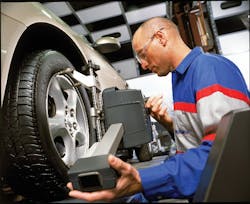As automakers over the past year have been playing whack-a-mole — attacking everything from COVID-19 production shutdowns, part and microchip shortages, and supply chain problems — it means there have been plenty of disruptions at the neighborhood car dealership. And that presents tire dealers with opportunity, but also some fresh challenges.
First things first, the credit for the whack-a-mole analogy (and the visual description that comes with it) goes to David Colletti, vice president of original equipment sales for Sumitomo Rubber North America Inc. That’s how he set up the state of the OE business during the company’s most recent dealer forum.
“COVID's kind of been whacked down; microchips have popped up pretty significantly and supply chain is lingering in the background, causing disruptions in the whole industry.”
Colletti says the microchip situation is predicted to extend beyond 2021 and will have a significant effect on total vehicle production in the U.S.
“The latest projections are (that) about 1.5 million vehicles will not be produced in North America this year because of the (lack of) microchips,” Colletti says. “Considering that North America typically outputs about 15 million vehicles, this is a 10% reduction in vehicle production just because of the microchips. It is anticipated the microchip situation will continue for at least the rest of this year and into 2022.”
Adding to that is the shortage of shipping containers and backlogs at the West Coast ports that tire dealers are already familiar with.
“We have seen supply chain disruption with congestion at major ports such as Long Beach and congestion at railyards such as Chicago and Tennessee,” Colletti says. “Even if parts are produced overseas, if the vehicle manufacturer can't get the parts off the boat or off the train, they just simply can’t make the vehicles. This has been one of the major disruptions in 2021.”
Even with all of that as a backdrop, new car sales are strong. In May, Colletti says the seasonally adjusted annual rate hit 17.1 million vehicles — “well above the forecast of 16.2 to 16.7 million vehicles.” It’s down from April’s 18.5 million vehicle rate, but “well above the 12.1 million pace a year ago,” he says. The seasonally adjusted annualized rate has surpassed 16 million vehicles every month except for one since September 2020 and Colletti says it’s been hovering around the 17- million mark for three months straight. “The demand for new vehicles is extremely strong.”
And it all adds up to a shortage of new car inventories. Colletti says new vehicle supplies totaled around 1.95 million vehicles in May, down from 2.24 million at the end of April — and down another 1.4 million from a year ago. Colletti says, “The average number of days a vehicle sits on a vehicle lot is now 47 days. It was 95 days a year ago.”
What does it mean for tire dealers?
Even though there’s strong demand for new vehicles, there’s inadequate supply to meet the demand. And that means plenty of consumers are choosing to maintain their current vehicles for a little longer. This means there’s an opportunity for tire dealers to sell another set of tires. And there’s an opportunity for tire dealers to inspect vehicles again and also perform maintenance on vehicles that owners might otherwise have not planned to do.
At SRNA, that means while Colletti’s OE tire sales are down, his replacement tire counterpart, Matt Leeper, is seeing a boost in tire sales.
IHS Markit’s June data confirms that the cars on America’s roads are getting older. The light vehicles in operation in the U.S. now average 12.1 years old, an increase of almost two months during 2020 due to COVID-19.
“The increase in average age will further drive vehicle maintenance opportunities from an increasingly aged vehicle fleet,” IHS Markit says.
But the company expects the increase in vehicle age to be “short-lived” as the country adapts to “post-pandemic norms.” It expects new vehicle sales to reach 16.8 million in 2021.
“The microchip shortage and subsequent inventory levels for new vehicles have created a situation in which used vehicle values have gotten extremely high, so a vehicle owner who may have kept a vehicle in the garage that they were not using in 2020 now instead may take advantage of the opportunity to either reduce the number of vehicles in their garage or trade up to something newer while the demand and value is extremely high on their used vehicle,” said Todd Campau, associate director of aftermarket solutions at IHS Markit. “This is great news for the aftermarket as subsequent vehicle owners typically have a higher propensity to use independent repair shops for necessary maintenance and repair.”
For tire dealers, one downside to the instability at new car dealerships is that those new car dealers are picking up speed in the tire business again. SRNA saw evidence of that in early June. Leeper said the company’s national account with FCA and Ford shows those dealer customers were “off to a really strong start in June.
“One theory is that they’re not selling new cars, so they’re focusing their efforts on tire sales. I don’t know if that’s right or not, but it sounds like it could be the case.”
About the Author
Joy Kopcha
Managing Editor
Joy Kopcha joined Modern Tire Dealer and Auto Service Professional as senior editor in 2014 after working as a newspaper reporter for a dozen years in Kansas, Indiana and Pennsylvania. She was named managing editor of MTD and ASP in 2022, and took on that same role with Motor Age in 2024.
She is an award-winning journalist, including in 2023 when she was named a Jesse H. Neal Awards Finalist.
Don't miss any of her articles. Sign up for MTD's newsletters.

